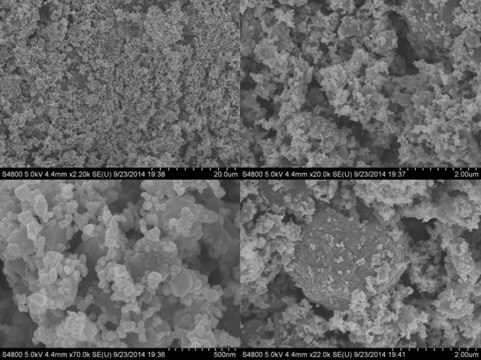725137
Lithium manganese dioxide
powder, <1 μm particle size, ≥98% trace metals basis
About This Item
Recommended Products
grade
battery grade
Assay
≥98% trace metals basis
form
powder
mol wt
Mw 93.88 g/mol
composition
LiMnO2
greener alternative product characteristics
Design for Energy Efficiency
Learn more about the Principles of Green Chemistry.
sustainability
Greener Alternative Product
particle size
<1 μm
mp
400 °C
density
4.1 g/cm3 (lit.)
application(s)
battery manufacturing
greener alternative category
SMILES string
[Li+].O=[Mn-]=O
InChI
1S/Li.Mn.2O/q+1;-1;;
InChI key
HSDMUHSXXGFNMK-UHFFFAOYSA-N
Related Categories
General description
Application
- Safety of a continuous glucose monitoring device during hyperbaric exposure.: This study examines the safety and performance of a continuous glucose monitoring device under hyperbaric conditions, highlighting the reliability and durability of Lithium manganese dioxide batteries in medical applications (Bliss et al., 2020).
- The 6 volt battery for implantable cardioverter/defibrillators.: This paper discusses the use of Lithium manganese dioxide batteries in implantable cardioverter/defibrillators, emphasizing their high energy density and long life, making them ideal for critical medical devices (Drews et al., 1998).
Features and Benefits
Li-Batteries, material for electrodes design and manufacturing
related product
Storage Class Code
11 - Combustible Solids
WGK
WGK 3
Flash Point(F)
Not applicable
Flash Point(C)
Not applicable
Choose from one of the most recent versions:
Already Own This Product?
Find documentation for the products that you have recently purchased in the Document Library.
Customers Also Viewed
Articles
Increasing fuel costs and concerns about greenhouse gas emissions have spurred the growth in sales of hybrid electric vehicles (HEVs) that carry a battery pack to supplement the performance of the internal combustion engine (ICE).
Nanomaterials for Energy Storage in Lithium-ion Battery Applications
Professor Qiao’s laboratory lays out recent advances in conversion type lithium metal fluoride batteries. This review explores key concepts in developing electrochemically stable microstructures for wide Li-ion insertion channels.
Electrode Materials for Lithium Ion Batteries
Our team of scientists has experience in all areas of research including Life Science, Material Science, Chemical Synthesis, Chromatography, Analytical and many others.
Contact Technical Service










